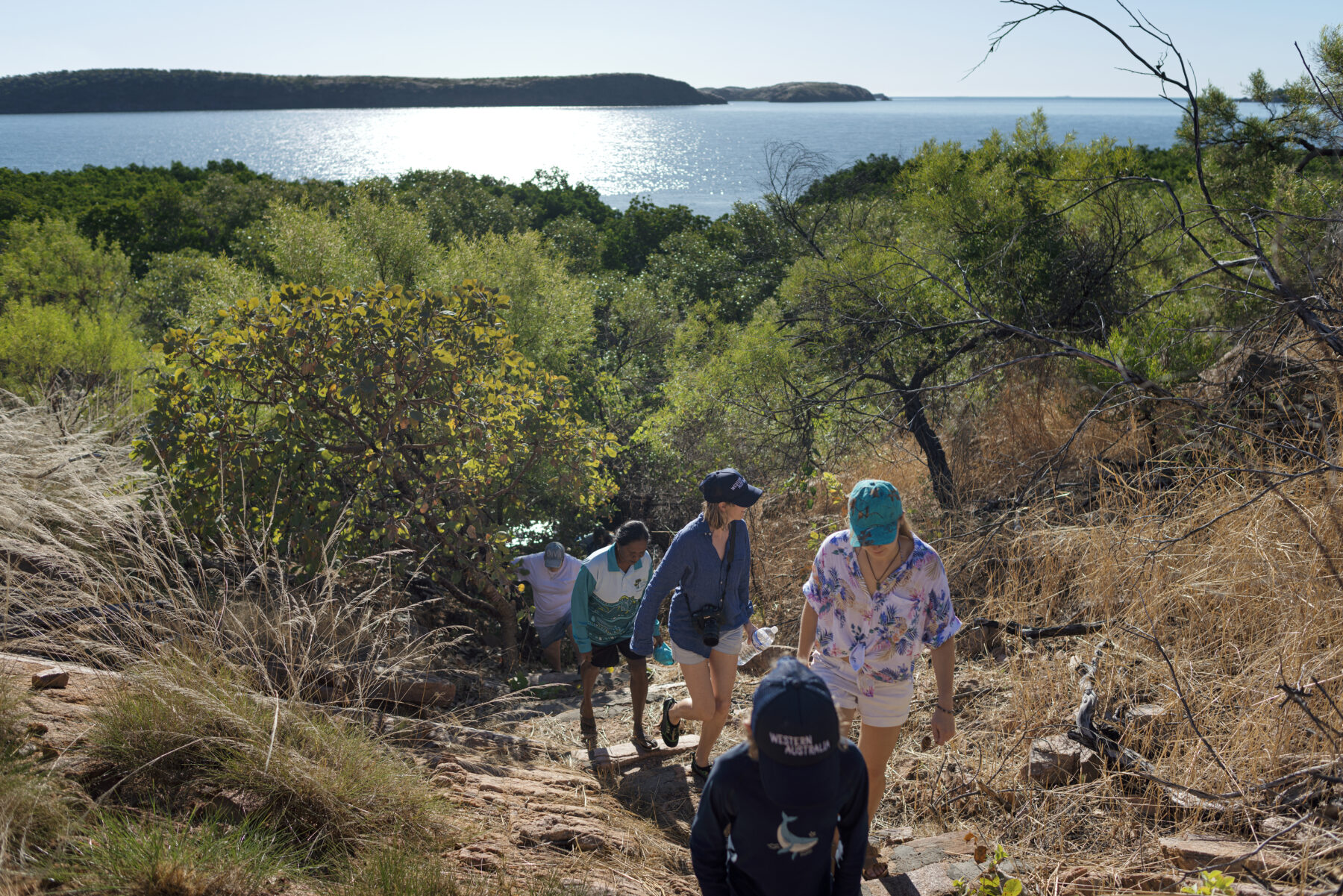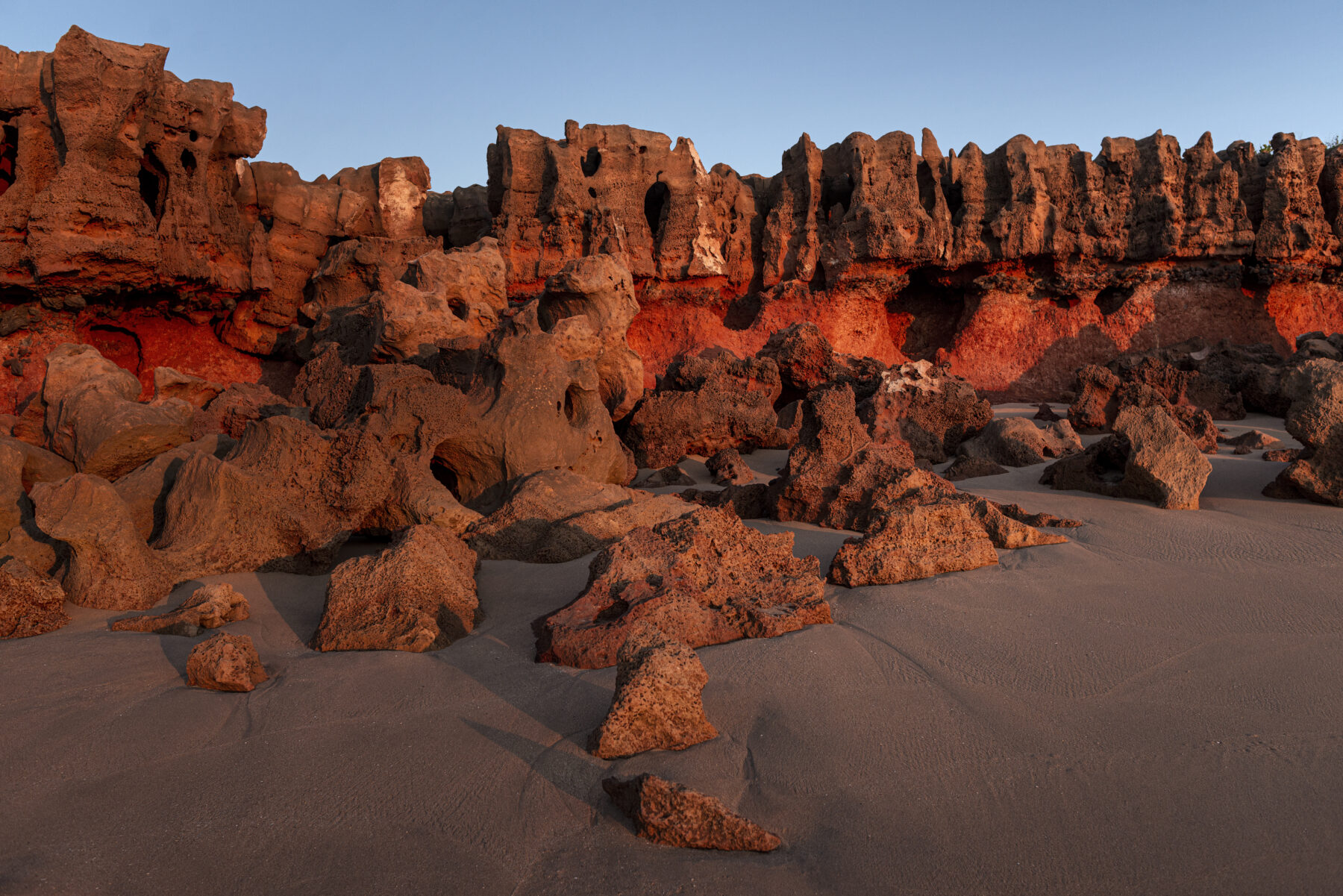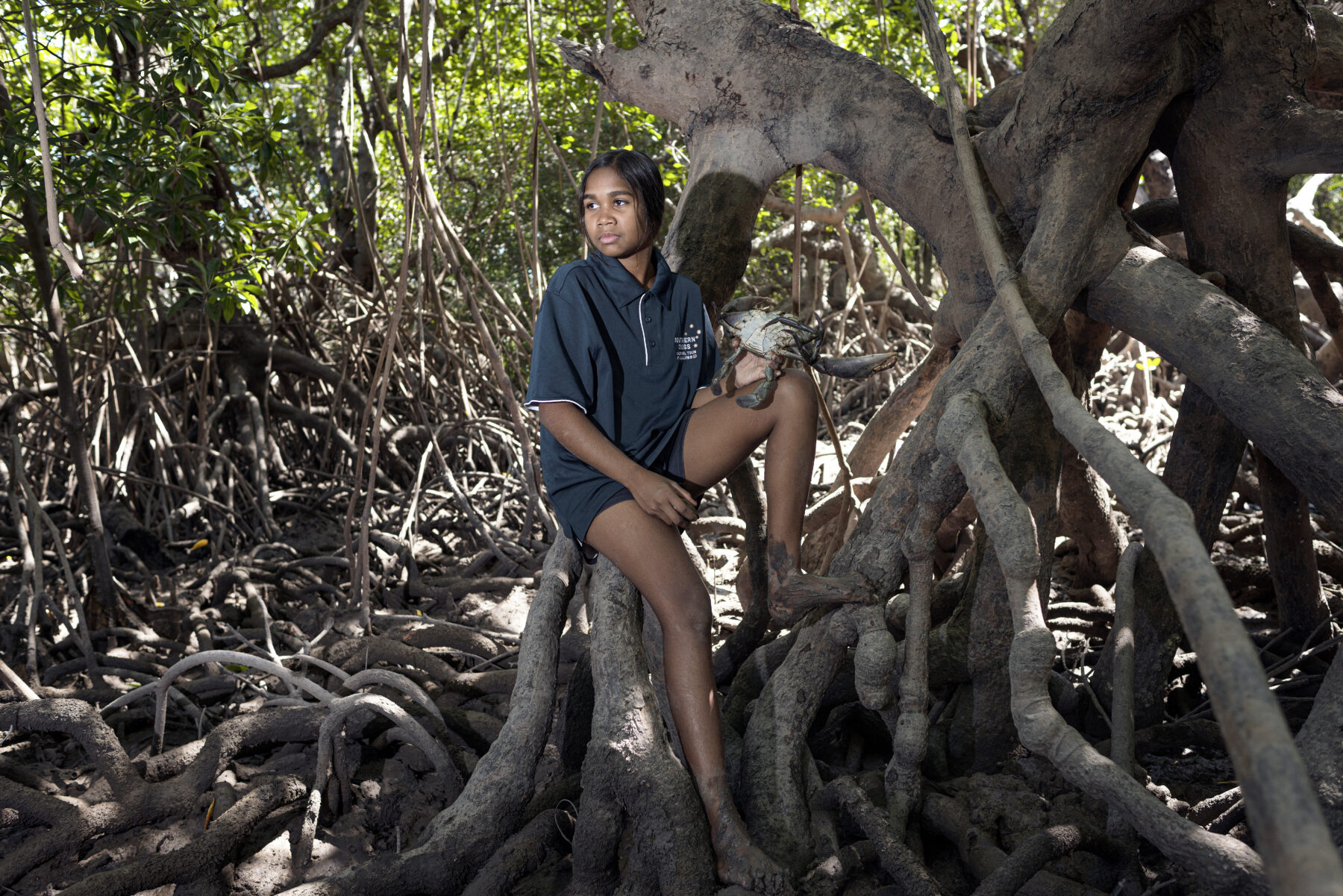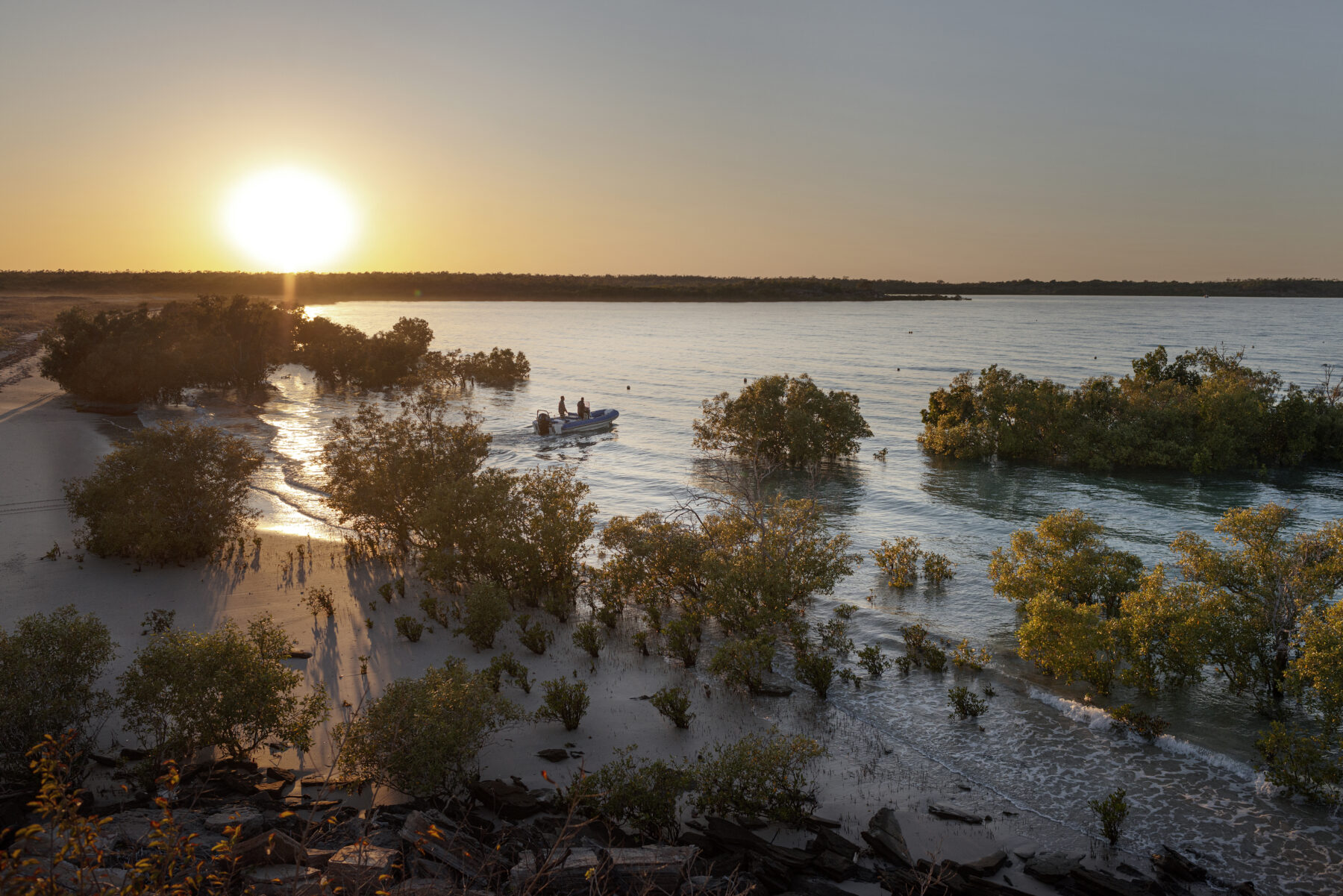When Bardi Jawi woman Rosanna Angus looks across the world’s largest tropical tides, here in north-west Western Australia where they teem past 2-billion-year-old rocky islands, she sees things most others don’t. Rosanna is the Dampier Peninsula’s first Indigenous woman owner-operator guide. And as she gazes across millennia, she pictures her forebears clinging to rafts fashioned from mangroves and spears, deftly manoeuvring the churning ocean in King Sound, about 190km north-east of Broome.
Until as recently as the early 1900s, those traditional tide drifters were navigating the whirlpools here, riding over giant bubble-pop boils and whooshing past hamster-wheel waves kicked up by submerged rocks. They harnessed those monstrous currents to travel, trade and forage in one of the most remote places on earth. Yet their saltwater story is only just being told to a modern audience – over the sound of twin-propeller engines labouring against those same powerful currents like a four-wheel-drive churning through sand. Dressed in a bright turquoise shirt that matches the colour of the water, Rosanna retraces the aquatic journeys of her ancestors and invites the curious onto Sunday Island. She knows it as Ewuny, a boulder-stacked place where three clans once lived – a place that can now only be accessed with a Traditional Owner (TO). En route, Rosanna hands me a binder folder bloated with plastic slips. I leaf through black-and-white photographs of people wearing hair belts threaded with riji (carved pearl shells), of rectangular, round-edged grass huts, and of the mission established after first contact in 1899. Nature and storytelling act as a bridge across time.

Access to such other-worldly stories is not what Broome and its surrounding baked red lands are known for. The bustling holiday town’s image is one of lustrous pearls, “flop-and-drop” poolside escapes and camel trains on Cable Beach. Yet more than 40,000 years’ worth of history is in Broome’s palm and at its ochre fingertips. Although hordes of jetsetters and cruise travellers swoop in on Kimberley bucket-list sites, comparatively few venture beyond the town’s sandy perimeter and even fewer onto traditional lands. Visitors might notice the town’s visibly multicultural mix, which is a legacy of frontier fortune-hunters and indentured workers. But there’s little recognition that some 84 First Nations communities are in the sweeping net thrown by the Shire of Broome. That’s despite the latest visitor research showing more than 80 per cent of people coming to WA want an experience with the world’s oldest continuing culture. Desire hasn’t translated to success, with less than 17 per cent of visitors managing to have that experience.
But those giant Kimberley tides are turning. A record 10 Aboriginal tourism businesses are now operating in Broome, and another 22 speckle its northern reaches, making genuine First Nations interactions more accessible than ever before. The WA Indigenous Tourism Operators Council (WAITOC), in step with the WA state government, has an ambitious goal for the state to become the nation’s leading destination for authentic Aboriginal tourism. Called the Jina Plan, which broadly translates to “discoveries”, it will allow more TOs to share their stories and stay on Country. And that means a different picture is being painted that’s changing the face of Rubibi, the destination otherwise known as Broome.
Before the town’s establishment was even dreamt of, Aboriginal clans lived seasonally along Roebuck Bay, where Broome’s resorts, pubs and pearl boutiques now stand. The region’s pearl shell had sacred status and, astonishingly, has been found right across Australia, including in the desert. There’s evidence it was carved, worn and traded, and used for ritual, ceremony and law, for more than 22,000 years. This makes it one of the world’s earliest forms of currency. Disruption of Aboriginal occupation began in the mid-1800s. There were bloody frontier conflicts with explorers and pastoralists, but it was the ‘discovery’ by Europeans here of the world’s largest mother-of-pearl shell species that changed the First Nations story forever. From the 1860s onwards, many Indigenous people were used as slave labour to dive deeper and for longer than what, in many cases, was humanly (or humanely) possible. After the turn of the century, 80 per cent of the world’s mother-of-pearl shell – fashioned into buttons – came from about 400 luggers working out of Broome. The impact on the landscape and its people was dramatic.
“The pearling fleet used the site where the Mangrove Hotel is now as their landmark; it was a beacon when coming in from the sea,” says Yawuru man Bart Pigram as he leads a gang of adventurers in neoprene booties to places they’d never otherwise go. We walk along a red sandy stretch below a row of pool-fronted hotels. The 2km route Bart traces several times a week runs through the low-tide ecosystem edging Roebuck Bay, where the luggers once crowded. “From here you can look back to a dune that’s a protected site. Cockle and pipi shells are strewn everywhere there, showing evidence of Aboriginal activity over millennia,” he says. “You’re looking at the first contact site right there.”

Turning into a wide swathe of mangroves glowing in hues of chartreuse, we’re met with limbs that stretch above our heads and roots that loop from our ankles to our knees, and we connect with the time before Broome was Broome. We squelch through mudflats, listening to Dreaming stories explaining the placement of freshwater springs and how a lone rock island came to be. We happen across a rare baler shell, a snail-like sea creature the size of a child’s head. It was so called by Europeans who saw Aboriginal people bailing water out of canoes with them. “I’ve only seen three of those in the past 20 years here; they’re very, very rare,” Bart says, as he snaps a photo. “They used to be everywhere.”
Bart is the first of a new breed of younger operators testing Broome’s tourism waters. In 2015 the 41-year-old co-curated a podcast project designed to act as a free, self-guided walk for visitors. It sparked something in him he hadn’t expected. “Hearing the stories of 27 Elders of Broome – of all different races – made me feel like we needed to do more on this area,” he says. “A lot of the focus was on Cable Beach.” Hearing people still wanted live commentary, he began running cultural walking tours – Narlijia Experiences Broome – that same year. “There was a massive gap and a huge demand,” he says. “The market was crying out for Aboriginal experiences. It just hasn’t been accessible.”
In the past five years, Bart says the number of cultural businesses has jumped significantly. Once COVID restrictions lifted, word began to spread. He’s hopeful it’s the dawning of a new age. “I’ve always had the vision of – instead of having camels on Cable Beach – Aboriginal tourism being just as iconic to the Kimberley and Broome as camels or pearls,” he says. “I think we’ll get close in the next five years.”

Bart is well placed to realise his vision. In 2023 he became the first Aboriginal person to be appointed to Australia’s North West Tourism Board. He sees his role as a cultural go-between, connecting Indigenous and non-Indigenous tourism players so the two can build mutual understandings and prosper together. “The Kimberley is 98 per cent native title land,” he says. “Now we are stakeholders. A lot of Broome’s big businesses want to work with Aboriginal communities and operators.”
The town’s first Indigenous co-owned craft brewery is a prime example. Spinifex Brewing Co. is no backyard operation, with the business entering the export market this year. Their products are stocked in 60 IGA stores in WA, and the company aspires for them to be served on national flights. The CEO, Adam Barnard, says its focus on developing Indigenous employment is as strong as its love for making low-alcohol beers infused with native produce. Launched in 2019, Spinifex Brewing has engaged some 200 First Nations people to collect gubinge (Kakadu plum), a fruit used in its non-alcoholic ginger beer, and partners with an Aboriginal family-owned farm growing lemon myrtle, Geraldton wax and wattle. When it swapped its pop-up premises for a 4500sq.m dedicated space a block from Cable Beach in December 2023 (supported by a WA state government grant of almost $2 million), the brewery planted a food forest of Indigenous botanicals that will soon be harvested and used as an education resource. Fittingly, the spent grain will be fed to the Red Sun camel trains that pass the location each day.
Perhaps most significantly, Spinifex Brewing is working with Broome’s North Regional TAFE to provide apprenticeships and employment for Aboriginal hospitality students. As I sip a Cable Beach Sunset Ale in Broome’s balmy air, Adam says the brewery aims to create supply chains that will fuel First Nations enterprise. “The bigger picture is that we’re trying to create change,” he says. “We want to support the formation of new Aboriginal businesses, and empower them to separate from the business so that we can then subcontract them.”
Crocodile wrangler Johani Mamid is another driver of Broome’s new identity, where business smarts and social enterprise combine with the poetry of culture. The Yawuru, Karajarri, Nyul Nyul and Bardi man, who was born and raised in the town, started Rubibi’s only public maru (corroboree) experience in 2022. The dancing ground is found on Broome’s outskirts, fringing the Malcolm Douglas Crocodile Park where Johani works.
A small sign for Mabu Buru Tours winks from the highway, catching my eye as I overshoot the entrance. I relatch the gate after entering and follow a dirt track through the bush to a clearing, where damper cooks on coals and water boils for billy tea.

Traditional maru is rarely shared beyond language groups; unveiling it, Johani says, is part of a gentle reconciliation. “What we share is what we do when we’re catching up with family,” he says. “We’re actually practising our culture; it’s not put together for the sake of tourism. We invite you to be part of our family for the afternoon.” The performance is true to form: as Johani recounts Dreaming stories, Karajarri Elder Uncle Mervyn Mulardy interjects, ironing out creases in the tale. “Our mob never had a library; it’s up here,” Johani says as he taps his head. “So we’ve got to pass on the knowledge of that library.”
The duo tell their lighthearted stories in stages, interspersed with song and dance. It’s slow paced, almost meditative; a sense of calm falls over us as the sting of the dry-season sun softens. Two Pintirri dancers emerge, holding white-painted spears adorned with feathers. White body paint frames their faces and torsos, with white cloths doubled over at the knees and tied at the waist. They sing and stamp their feet, using boomerangs as clapsticks. Each role, from damper to dancing, is designed with empowering outcomes in mind. “Adding the cooking element brings in more family,” Johani says. “With the dancing, the younger fellas do it better than the older men. They’re practising their culture at the same time and that builds pride.”
It goes further. Mabu Buru has been set up as a foundation, with 50 per cent of its earnings going towards ceremonial practices and the community. Families have been brought out on Country for the first time in decades. “The legacy of Mabu Buru Tours has been to become a social enterprise with self-determination, finding solutions for ourselves,” Johani says. “We’ve found a potential solution to living in these two worlds.”
A minute or two by car from Mabu Buru’s base camp lies the start of the long, outback road into Ardi, the great north-eastern slab of cinnamon-stained land commonly known as the Dampier Peninsula. For decades, the main arterial route linking Broome with First Nations communities, remote coastal camps and a pioneering pearl farm was etched with deeply corrugated red dirt – the kind that makes your teeth jar. The decision to lay some $65 million-worth of bitumen on the 200km stretch was a big deal, and took two years to complete. The sealed Broome–Cape Leveque Road was finished in November 2020, only for COVID to prolong its widespread use until WA’s hard border reopened in March 2022. Its significance can’t be overstated. It opens up access to First Nations culture like never before.

For Bardi woman Pat Channing and her husband, Dave, the newly sealed road has halved her travel time to her ancestral land. “It’s an enormous difference with the road being sealed,” she says. “The number of people visiting now has increased three or four times. The other day I even saw a motorbike!”
Indeed, the Cape Leveque Road can now be tackled in a 2WD, so long as dry seasonal conditions prevail. A 4WD is still recommended for destinations along its longer, sandy side routes. The Channings’ Mercedes Cove Exclusive Coastal Retreat is one such spot, found 33km off the bitumen. The couple cleared a bush site to build their home more than two decades ago. “The road was terrible when we first came up,” Pat says, remembering blown tyres. “It would take three hours if I was driving – four if someone else was,” Dave chimes in. The couple opened their headland perch to camping in 2007 and added cabins soon after. Their maximum capacity is 18. “I wanted to share Country with people and teach them a little about bush foods, or who I am and where I came from,” Pat says. “I wanted to show wider society that, as Aboriginal people, we can achieve what we want to achieve, using the land as a tool to get where we want to go.”


Bardi woman Pat Channing (left) has run Mercedes Cove Exclusive Coastal Retreat with her husband, Dave, for 16 years; Master hunter Bolo Angus (right) is a Bardi Jawi man whose warm, inclusive nature makes those on his foraging tours feel at ease. His 4WD adventures finish with a feast of treacle-laden damper and hot-to-touch crab claws, all cooked over a crackling fire.
Pat’s story is typical of many families who grew up in pre-1967 racially segregated Broome. Her Malaysian father, who arrived with the pearling fleet, was often torn away at night by police, whose torchlight flashed around the family home as they searched for him. Pat’s Aboriginal mum could only marry Pat’s father with the approval of a white Australian.
It wasn’t until Pat was born, the third of 10 kids, that the two gained permission – until then, her dad was regularly thrown in jail for spending nights with her mum. “I got upset by that for maybe a couple of years, then I decided to use it as a tool to go forward,” says Pat, who is comfortable recounting her personal history, including her grandmother’s Stolen Generation experience, to guests. “I don’t open up and talk about it, but if they ask, I will,” she says. Pat says her mother, Mercedes, pushed her kids to learn and ensured they spoke English. “She’d say, ‘Education is your key: you’ve got to do better than, or equal to, a white person.’”
Pat’s strong work ethic has seen her recently invited to be a tourism mentor. It’s something “Mum Pat” has long been doing informally with Rosanna Angus, of the tide drifters, who was named Australia’s best tour guide at the Top Tourism Towns Awards in September 2023. Pat also encourages Rosanna’s equally enigmatic brother, Bolo, who is teaching the next generation – his daughters, Makah, Malati and Maureen – how to lead his popular tag-along 4WD tours, spearing mud crabs in mangroves, digging up edible tuber roots and racing hermit crabs. As an experienced business owner, Pat understands the importance of reliability – something Aboriginal tourism in the region has often grappled with. “You’ve got to be 110 per cent committed,” she says. “You can’t just decide you don’t feel like it one day.”

With traffic increasing along the Cape Leveque Road, consistency will undoubtedly be tested. Further north, Lombadina Aboriginal Community is expecting tourism numbers to rise dramatically once its new camping ground, part of WA’s Camping with Custodians initiative, opens in May this year – the second on the peninsula in as many years. It’s only 3km off the bitumen.
“A lot more people have come already – a lot more caravans and campers – because with the sealed road, they can,” says Garry Sibosado, a pearl shell carver who carries on the Bardi people’s unbroken riji tradition from a tin shed with his brother, Darrell. The two are widely exhibited artists and plan to incorporate large-scale public art into the new camping ground, creating a trail leading guests into the community. “It’s educating people,” Darrell says. “People assume Aboriginal art is dots – that’s what they know. People also don’t realise they’ve travelled through five different nations to get here.”
If anyone straddles two worlds, it’s Terry Hunter and James Brown. Best friends since childhood, the barefoot pair went to school in a corrugated tin hut on James’s family pearl farm, a 20-minute drive from Lombadina. Terry’s Bardi Jawi family showed James how to spear, fed him hot damper with tinned jam, and taught him the sentiment of liyarn, which he says is “making a decision so the feeling inside you is right”.
The Brown family, who began pearling in 1946, have a long history of positive collaboration with Aboriginal people – so much so that they were shunned by the white community. “The Brown family did something that no other European had done in that era: go out and look for Aboriginal families and hold them close,” Terry explains.
James, who is Cygnet Bay Pearl Farm’s managing director, is quietly continuing that legacy. “The plan was that the next generation would always have somewhere they could work,” he says. Terry is the fourth generation of his family involved with the property. “Terry’s the first to have started his own business, a tourism business,” says James, whose team supports Terry, Rosanna Angus and other Traditional Owners with booking systems, boat access, staffing, locations, venues and marketing, helping ensure their product is reliable, accessible, and possible. “I see it as a natural evolution of the relationship that’s been there for a long time,” James says.

Terry delivers lively pearl-farm tours and, for the past three years, has been leading his own experience, Borrgoron Coast to Creek Tours, seeking out traditional food while sharing bush magic.
“This out here is my school,” he says, sweeping his hands around the ribbed tidal flats revealed by receding sea water that has also uncovered rocks made gritty and sharp with oyster shells. “People think the oysters are dead when the rocks are dry. But they’re all alive and good to eat.” At first, Terry employs modern harvesting methods. “I’ve got good traditional tools here – a hammer and chisel from Bunnings,” he deadpans, while tapping a rock-bound shell until the lid lifts off.
Next, he demonstrates the traditional way. Gathering a swag-sized bundle of spinifex, he lays the needle-tipped grass over an oyster-smothered rock and sets it alight. “You’re told never to play with fire, right? As kids, one of the first things we learn is how to use fire. It’s very important,” he says, stepping back from the intense heat as oysters whistle and fizz. “At every camp along the coast you won’t find any rock oyster shells,” he says. Lids pop while shells remain in place; I scoop the hot oyster flesh, sweet, salty and infused with smoke – it’s staggeringly good. “I don’t see this as work,” Terry says. “I’m just home.”
As with every operator I speak to, Terry senses that the growth in First Nations tourism is changing the way people see Broome and its environs. “I’ve seen a difference in the way travellers interact now with Broome. People are looking for culture and history,” he says, happy that access to it is growing. “Personally, it makes me feel so proud. I get to express myself and share my knowledge that has been handed down to me, so if someone walks away with that better understanding, it makes my day.” With that, Terry says, his liyarn blooms. “I want you to come with it, and leave with the liyarn, the good gut feeling,” he says. “It’s all about sharing.”
Australian Geographic Travel is proud to be partnering with Rosanna Angus on a Women-Only Exclusive Oolin Sunday Island Tour. Read more about this once-in-a-lifetime experience.
